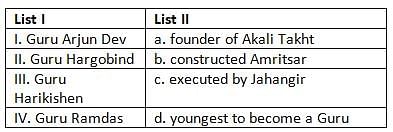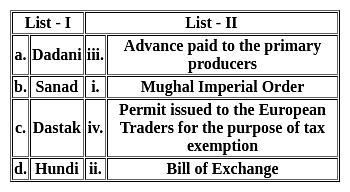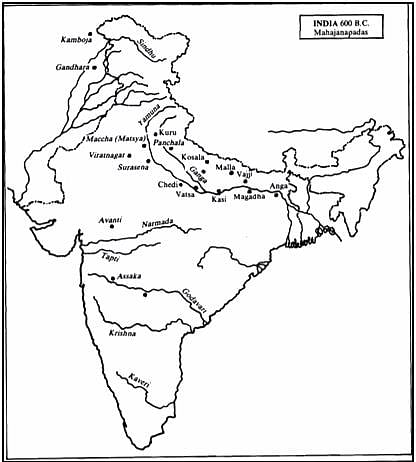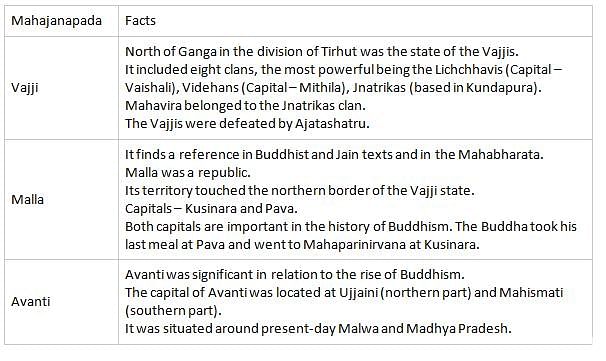TS SET Paper 2 Mock Test - 3 (History) - TS TET MCQ
30 Questions MCQ Test - TS SET Paper 2 Mock Test - 3 (History)
The First Cotton Textile Mill was established in India at
Which of the following statements are correct regarding the Mahalwari System of land revenue?
- It was introduced in the Ganga valley, the northwest provinces, parts of central India and the Punjab.
- The revenue settlement under this system was done with landlords or heads of families who collectively claimed to be landlords of the village or the estate.
- Under this system, the land revenue was determined on a permanent basis.
Select the correct chronological order using the codes given below:
| 1 Crore+ students have signed up on EduRev. Have you? Download the App |
Ratnasagar, Ratnaranjaka and Ratnodadhi Library buildings were the part of:
What is the descending order of military cavalry composition according to Barni?
1. Sarkhel
2. Sipahsalar
3. Amir
4. Malik
Which of the following assertions best describes the ideology and methods of the Assertive Nationalists within the Indian freedom movement?
Who raised the slogan "Swaraj is my birthright and I shall have it"?
With reference to the Anglo-Maratha Wars, consider the following statements:
1. The main cause of the first Maratha war was the increased interference of the British in internal and external affairs.
2. The First Anglo-Maratha War was fought between the British East India Company and Maratha Empire, during 1775 - 1782.
3. After many battles both Marathas and Britishers signed the Treaty of Salbai to Conclude the first Anglo-Maratha War in 1782.
Which of the above statement is/are correct?
With reference to the Malwa School of painting, consider the following statements:
1. It flourished between 1600 and 1700 CE and is most representative of the Mughal courts.
2. Its three-dimensional simplistic language appears as a consummation of stylistic progression from the Jain manuscripts to the Chaurpanchashika manuscript paintings.
3. A large number of Malwa paintings discovered from the Datia Palace collection supports a claim for Bundelkhand as the region of painting.
4. Malwa School defies a precise centre for its origin and instead suggests a vast territory of Central India, where it got articulated with a sporadic mention of a few places, such as Mandu, Nusratgarh, and Narsyang Sahar.
Which of the statements given above is/are correct?
With reference to the Battle of Plassey, consider the following statements:
1. The Battle of Plassey became famous because it was the first major victory the Company won in India.
2. After the defeat at Plassey, Siraj Ud-Daulah was assassinated and Mir Qasim made the nawab.
3. After the battle of Plassey the Company immediately took over the responsibility of the administration.
Which of the statements given above is/are correct?
Consider the following statements
1) The Chinese pilgrim Fa-Hien attended the fourth Great Buddhist Council held by Kanishka.
2) The Chinese pilgrim Hiuen-Tsang met Harsha and found him to be antagonistic to Buddhism.
Which of the statement(s) given above is/are correct?
Consider the following statements, with reference to the Pali texts.
1) The peasants had to pay one sixth of their produce.
2) Taxes were collected through an intermediate landlord between the peasant and the State.
Choose the correct statement.
Match List - I with List - II and select the correct answer from the codes given below :
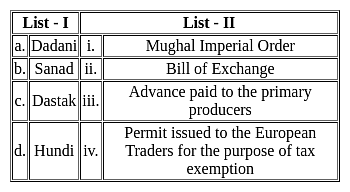
Louis Fischer, the biographer of Mahatma Gandhi, was associated with the movement of-
In the context of pre-Mauryan history, consider the following statements:
1. The Mahajanapada period is referred to as the first urbanisation.
2. During this period, the political centre shifted from Indo-Gangetic plains to lower Ganga valley.
3. The 16 mahajanapadas find reference only in Buddhist scriptures.
4. Among the mahajanapadas, rajyas were monarchies and ganas were republics.
Which of the above statements is/are not correct?
Consider the following statements regarding Natesa, the 9th century’s rare sandstone idol.
1. It is a rare sandstone idol from the Dravidian Style of architecture.
2. It was stolen from a temple in Tamil Nadu and smuggled to the UK.
Which among the above statements is/are correct?
The Rashtrakuta king who defeated the Pratihara ruler Nagabhatta II was
Which of the following states was first to be annexed by Lord Dalhousie under the Doctrine of Lapse?
Which of the following Mahajanapada had a large deposit of iron-ore?
Consider the following statements:
Assertion(A):- The Santhals were given land and persuaded to settle in the foothills of Rajmahal by the 18th century.
Reason(R):- They initially refused to cut forest, resisted touching the plough, and continued to be turbulent.
Which of the following rulers got the title of ‘Jagatguru’ by his Muslim subjects because of his secularist policies?
With reference to Lord Wellesley, consider the following statements:
1) The Civil Service was brought into existence by him.
2) He also established the College of Fort William for the education of young recruits to the Civil Services.
Which of the statements given above is/are correct?
Who was the first to formulate the theory of three successive phases of British colonialism in India, namely, Mercantilist, Free Trade Mercantile Capitalism and Finance Imperialism?
“Kings are made for Public; Public is not made for the King”. Who among the following made this statement during the national movement?


